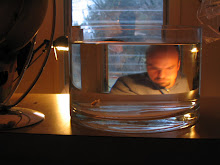
In one of Cleo's current favorite books, Angelina Ballerina, Mrs. Mouseling comes upon Angelina in front of a mirror, trying on her mother's hats and making various faces, while checking out her reflection. It's actually a rather interesting moment in the book's narrative arc, because it feels like a moment of pure, private vanity - but then becomes, we discover, a rather important part of the girl's training, which pays off when she ends up on the big stage. What seems like self-indulgent play, in other words, is actually useful practice, directed toward a specific end.
Because, after all - let's face it - all artists dissemble. The cave painter pretends, and asks us to pretend, that the ochre on the wall is actually the living, pulsing hide of a beast. The bluesman pretends, night after sweaty night, that his baby has just done left him. And the film editor, cooped up in a dark room, enables us, through a splicing of shots and countershots, to imagine that we are peering over the shoulders of the lead actor and actress. And why such dissembling? It's a necessary part, I suppose, of the project of mimesis - of the basic goal of so much Western art since Plato first used the term. Those violinists, with their bows hopping on their instrument bridges while playing Debussy's La Mer? They're doing their best to recreate, in our minds, the tremble of the sea - and, in the process, pretending that wooden curves are frothy waves.
And so, along the way, every child learns the process, as well. Perhaps they stand in front of a mirror, and try on costumes. Or perhaps they begin to sketch, with chalk or crayon. Or maybe, as Cleo did this week, they begin to mimic countenances associated with various moods. So, for your consideration: above is Cleo, asked to do a happy face. And below, Cleo again, imitating crazy and sad faces. Sure, it's simple fun. But when Angelina makes a career of her interest, it then seems like more than mere fun, as well.
And so, along the way, every child learns the process, as well. Perhaps they stand in front of a mirror, and try on costumes. Or perhaps they begin to sketch, with chalk or crayon. Or maybe, as Cleo did this week, they begin to mimic countenances associated with various moods. So, for your consideration: above is Cleo, asked to do a happy face. And below, Cleo again, imitating crazy and sad faces. Sure, it's simple fun. But when Angelina makes a career of her interest, it then seems like more than mere fun, as well.






No comments:
Post a Comment